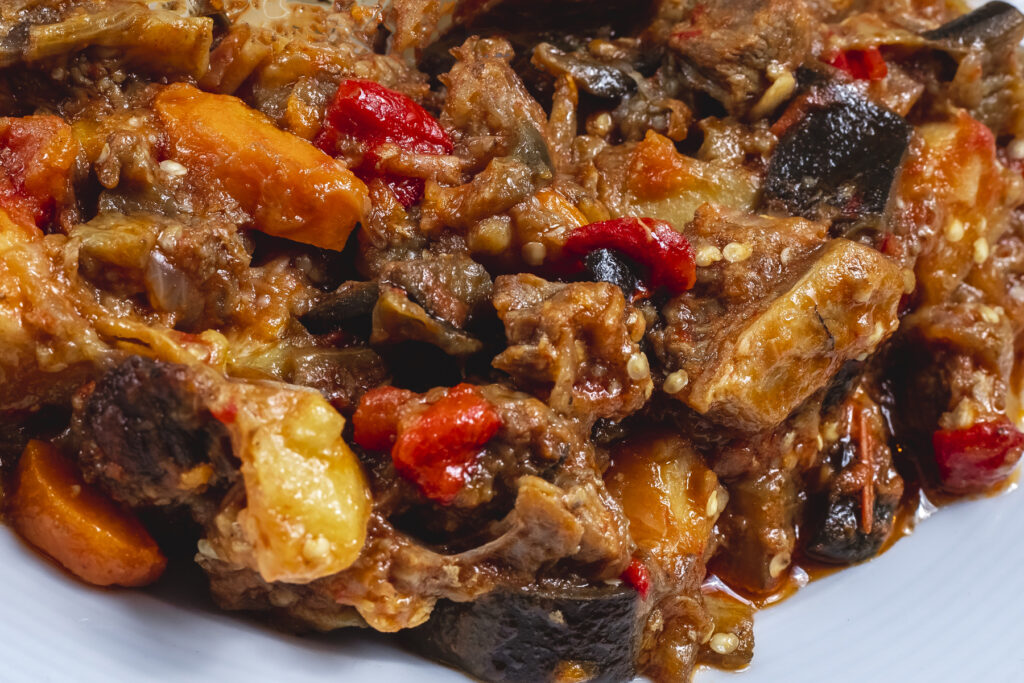I couldn’t travel to Egypt with my friend Pat… yet he made sure I had my taste of Egypt by sending me beautiful care package of Egyptian spices and teas. So lovely! And aromatic, and tasty… Pat loves to travel, loves to cook, loves the companionship of great friends…
The challenge was on… what to make with all these ethnic spices? You’ve likely heard of some like cardamom, turmeric, saffron, others are unique (not quite sure what to do with the Hibiscus powder and crystalline menthol—also called mint—apparently, if one is congested, can steep the crystals in hot water and breath in the vapors to open the airways).
What is tagine (or tajine)? A short piece of world history: Two meanings. First, it’s a North African ceramic cookware with a wide bowl-like base and distinctive cone-shaped cover. The tagine was traditionally used over slow coals to produce an extremely tender, succulent, dish—called tagine—typically meat, poultry, or fish, vegetables, and/or fruit. The word was initially thought to date back to the Roman empire as the first artifacts were found in Scottland dating back to Roman occupation. According to some sources, the history of tagine dates back to the time of Harun al-Rashid, the fifth Abbasid Caliph, a dynasty thought to have descended from the Mohammed’s uncle.
Slow cooking means you can use a tougher, less expensive, cut of lamb as long, low, slow heat allows the tendons and other connective tissue to become gelatinized further softening the meat and contributing important proteins for your joings and muscles. Elegant for company and simple enough for a work/school-night.
Ingredients:
3-4 lb leg of lamb / foreshank / hindshank…
2 Tablespoons of olive oil
1 Tablespoon ras el hanout, more to taste (literally translated as “head of shop,” the Arabic phrase ras el hanout really means “top shelf”.)
a large pinch saffron
1 Tablespoon raw honey
1 bay leaf
1 cinnamon stick
1 large onion, peeled and chopped
1 14oz canned organic fire roasted crushed tomatoes
1 cup bone broth from grass-fed animals (chicken or beef is commercially available—game animal broth is lovely)
2 cups butternut squash chunks
1 cup eggplant cubes
¾ cup pitted prunes, quartered
Egyptian-style pita pockets for dipping the sauce (or fill the pockets—this gets messy LOL—in this part of the world, dining is on floor cushions and served as finger food)
OR serve over rinsed and cooked quinoa
Chopped fresh parsley to garnish
Ras el Hanout (my version made with more common spices—traditional Ras el Hanout varies from family to family and spice merchant with the single requirement that it contain at least twelve individual spices—you will have plenty extra to label and store in your pantry)
1 teaspoon ground cumin
1 teaspoon onion powder
1 teaspoon salt
¾ teaspoon freshly ground black pepper
1 teaspoon ground cinnamon
¼ teaspoon cayenne
½ teaspoon ground allspice
¼ teaspoon ground cloves
1 teaspoon turmeric
1 teaspoon paprika
1 teaspoon garlic powder
¼ teaspoon ground cardamom
Preparation:
- Coat the inside of a large crockpot with olive oil, and place the lamb inside.
- Turn the lamb to coat with oil then sprinkle with the Ras el Hanout mix.
- For larger cuts of bone in meat: Add the saffron pinch, honey, bay leaf, cinnamon stick, and bone broth.
- Cover with the crockpot lid and take an intermission while it cooks for 4 hours on low heat (if your lamb came on the bone, the meat will start to separate off the bone at this point; remove the bone.)
- Add the chopped onion, fire-roasted tomato, butternut squash, eggplant, and prunes to the crockpot.
- Adjust seasonings to taste and continue to cook on low another 4 hour intermission until the vegetables are softened.
- Serve immediately with your pita pockets or over quinoa.
This is an unbelievably flavorful dish that, while it takes planning, is very simple to make.
Copyright © 2023 Marie Cecchini Sternquist. All Rights Reserved







